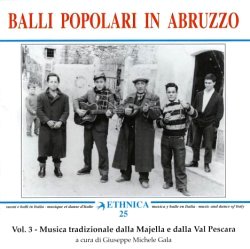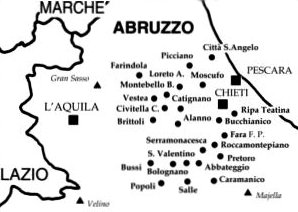Musica tradizionale dalla Majella e dalla Val Pescara
Taranta Ethnica TA025
Saltarella con tamburo; Saltarella cantata; Ballarella; Ballarella; Valzer; Polka (porca vecchia); Tre Passi; Denzė; Saltarella alia pescarese; Quadriglia; Quadriglia; Quadriglia; Valzer; Danzė; Quadriglia; Saltarella; Saltarella; Saltarella vecchia; Ballarella; Galoppo; Valzer Saltante; Balle A Zambitte; Ballarosa; Mazurka; Polka; Mazurka; Tarantella a 3 zumpi; Tre Passi; Ju Scossė; Denzė; Tre Passi; Ballo Della Sala; Quannė la fija me'; Passetto; Ballarella; Marcia Del Banderese.

For readers unfamiliar with the geography, Abruzzo is the regione to the east of Lazio (and Rome), bounded by Marche in the north and Molise in the south. It has a narrowish coastal strip along the Adriatic, but most of the land comprises the Apennine range - so it's pretty mountainous. Indeed, the Gran Sasso - tallest of the Apennine group - affords a view of both the Adriatic and Tyrrhenian seas; right across the entire width of Italy.
Squeezed between influences from both northern and southern regions, the traditional music of central Italy still retains its own very specific features. One such tradition is the saltarello dance, a common thread across the regions of Lazio, Abruzzo, Marche, and Umbria. Probably its roots date back to the saltatio, a lively dance which was very popular since the early Roman days along with the ballicrepa and the chorea. The saltarella music is particularly linked to the ddu bbottë, a small diatonic melodeon with one and a half rows of treble buttons. (This was commented upon in the review of Volume 2 of this set of CDs, which was concerned with the northern part of Abruzzo, the area around the city of Teramo. Volume 1 presented a compilation of saltarella and spallata dance music from the south-east of Abruzzo where the transition between saltarella and the southern tarantella takes various forms.) For the same reasons which have made the melodeon the instrument of choice for traditional dance musicians the world over, the ddu' bbottë has effectively eclipsed almost all other instuments in the area. Thus we find only 6 of the 36 tracks presented here played by other instruments!
When I reviewed the Rounder/Lomax Italian Treasury series release on Abruzzo, I noted that the immediate impression upon listening to this music is of how surprisingly Northern most of it sounds . But as we well know, culture generally, and music particularly, are no respecters of political boundaries - so there is not the hard and fast demarcation between the North and the South which many Italians today like to pretend exists. ![]() This comment seems to apply even more to this CD of dance music from Pescara, almost halfway down the regione (and its capital city), where we hear numerous tunes which might easily come from eastern England. This impression is magnified by the nature of the ddu' bbottë itself which, because of its limitations, produces music which is far more diatonic in style than is a lot of Italian organetto (melodeon) playing - particularly the more modern stuff.
This comment seems to apply even more to this CD of dance music from Pescara, almost halfway down the regione (and its capital city), where we hear numerous tunes which might easily come from eastern England. This impression is magnified by the nature of the ddu' bbottë itself which, because of its limitations, produces music which is far more diatonic in style than is a lot of Italian organetto (melodeon) playing - particularly the more modern stuff.
In his notes, Giuseppe Michele Gala comments that, for the most part, the old dances have been lost (and replaced, as so often, by the ballo liscio), but that there are still some musicians who remember, and play, the old music - which is what is heard on this CD.  The recording dates range from 1982 to 2005, so this is not a dead or revived tradition we're talking about. However, the old dances are gone - replaced by the southern tarantella, which is the 'new Celtic' these days in much of Italy, as we discovered in a trip to Val Pescara in 2004.
The recording dates range from 1982 to 2005, so this is not a dead or revived tradition we're talking about. However, the old dances are gone - replaced by the southern tarantella, which is the 'new Celtic' these days in much of Italy, as we discovered in a trip to Val Pescara in 2004.
Something which the booklet notes (or the English part, anyway) do not mention is the transumanza. For centuries the shepherds of Abruzzo engaged in a massive seasonal migration (transumanza); moving their flocks down into the tablelands of Apulia for the winter and returning to their own high pastures for the summer.
Several important characteristics of the musical traditions of the area stem from this fact. Firstly, co-operative shepherding and farmwork have been features of the economy for centuries - transhumance is documented as far back as the 15th century. Women left to run the farms alone for more than half the year whilst the men were away with their flocks on the 'great trail' obviously needed to co-operate with each other as well - and their economic importance was reflected by a higher social status than in other similar areas. When they worked together with men in the fields, it was the women to took the lead in the work songs!
Our own experience in Val Pescara last year revealed a female population well able to hold their own in any company (a higher percentage of women drive cars than anywhere else in Italy), and that it is they, rather than the men, who are the singers and the dancers. The men though, if this CD is anything to go by, remain the custodians of the music - that was our impression in 2004, and you'll find no women players on this record.
![]() Clearly, with a 36 track CD, it's not possible to comment on all of them, particularly when the great majority are rather similar; here's a bit of track 1 (sound clip right - Saltarella con tamburo). Some things do stand out, though, and track 17 - although described as a saltarella - sounds far more like a tarantella to me.
Clearly, with a 36 track CD, it's not possible to comment on all of them, particularly when the great majority are rather similar; here's a bit of track 1 (sound clip right - Saltarella con tamburo). Some things do stand out, though, and track 17 - although described as a saltarella - sounds far more like a tarantella to me. ![]() Rather obviously, the tracks you notice most are those not featuring the melodeon, so I'll leave you with a tune called Ju Scossė (sound clip left), which I assume to be some kind of Abruzzi schottische, although it sounds more like a northern European barndance, played on clarinet, tuba and guitar. Lovely stuff!
Rather obviously, the tracks you notice most are those not featuring the melodeon, so I'll leave you with a tune called Ju Scossė (sound clip left), which I assume to be some kind of Abruzzi schottische, although it sounds more like a northern European barndance, played on clarinet, tuba and guitar. Lovely stuff!
This very likeable CD is available from Felmay at: www.felmay.it
Rod Stradling - 27.10.05
| Top of page | Home Page | Articles | Reviews | News | Editorial | Map |